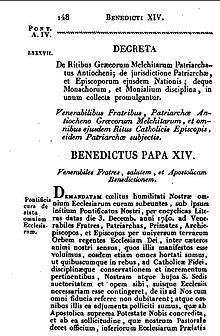- Demandatam
-
Demandatam coelitus humilitati nostrae is an encyclical[1], promulgated by Pope Benedict XIV on December 24, 1743, about the Melkite Greek Catholic Church. It is addressed to the Patriarch of Antioch Cyril VI Tanas and to all Melkite bishops under his jurisdiction, and is generally not considered ex cathedra. The subject of this encyclical is the full preservation of the Byzantine Rite in the Melkite Greek Catholic Church.[2]
Contents
Historical context
In the first part of the 18th century, many liturgical latinisations were introduced in some communities of the Melkite Catholic Church, mainly by Euthymios Saifi and Cyril VI Tanas, and supported by many Latin missionaries (mainly Franciscans) against the wishes of the papacy. These changes led to a division in the Melkite Catholic Church between those who went on following the pure Byzantine Rite (as the Basilian Chouerite monks) and those who, named Latinizantes in the encyclical, mixed the Byzantine Rite with the Latin Rite. Rome had already taken measures against the uses of the Latinizantes (e.g., the letters to Saifi in 1723 or the decree of July 8, 1729). However these measures did not resolve the issue, and in 1743, before granting the pallium to Cyril VI Tanas, Pope Benedict XIV issued the Demandatam encyclical to put an end to the mixture of liturgical rites.[3]
Content
The main points of the encyclical[4] are:
- it is forbidden to any one, including the patriarch, to change, to add or to remove anything from the Byzantine Rite and uses (para. 3);[5]
- it is forbidden to have any faithful to pass from the Byzantine Rite to the Latin Rite (para. 15);[5]
Concerning the Latinizantes (who mixed the rites), the encyclical orders that all the faithful baptized in the Byzantine Rite shall return to the Byzantine Rite. An exception is made for the area of Damascus where the Latinizantes were numerous: they had to choose between the Byzantine and the Latin Rites, and follow it without later changes or mixtures (para. 16). This letter deals also with the disciplinary issues of the Melkite religious orders.
Notes
- ^ sometime referred to also as an Apostolic Constitution
- ^ Dick, Ignace (1996). Les Melkites Greecs-Orthodoxes et Grecs-Catholiques des Patriarcats d'Antioche, d'Alexandrie et de Jérusalem. Brepols. p. 35. ISBN 250350308X.
- ^ Korolevsky, Cyril (1924). "Antioche". Dictionnaire d'histoire et de géographie ecclésiastiques. 3. Paris: Letouzey et Ané. pp. 649.
- ^ full text in Benedicti papae XIV. Bullarium. 2. Mechelen. 1828. pp. 148–161. http://books.google.com/books?id=xDERAAAAYAAJ&dq=editions%3AOCLC5049310&pg=RA7-PA2-IA1. Retrieved 2009-06-20.
- ^ a b Foskolos, Markos (1973). "L'unione parziale del Patriarcato di Antiochia (1724)". In Metzler J.. Sacrae Congregationis de Propaganda Fide Memoria Rerum. II. Herder. pp. 330. ISBN 3451163527.
External links
- Full text available online (Latin)
Categories:- Documents of the Catholic Church
- Papal encyclicals
- 1743 works
- Melkite Greek Catholic Church
Wikimedia Foundation. 2010.

